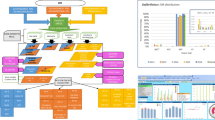Abstract
Most often, we observe that certain spare parts are used together for various maintenance activities of equipment. If spare parts are used frequently in a group, then there exists some hidden dependency among these parts. Sometimes the entire maintenance work cannot be accomplished due to the shortage of a single spare in the group. These parts are termed here as associated spare items. These parts can be determined by frequent itemsets mining. In this paper, the groups of spare parts are found out through hierarchical clustering method using support and weighted support of the data mining measure. A methodology is proposed to incorporate both support and weighted support values for computing an overall cost of replenishment for joint replenishment policy for the associated spares. Finally, a case study is presented to illustrate the validation of our model and compared the results among the group with normal support and group with weighted support.
Similar content being viewed by others
References
Atkins DR, Iyogun PO (1988) Periodic versus ‘can-order’ policies for coordinated multi-item inventory system. Manag Sci 34(6):791–796
Agrawal, R., Imielinski, T., & Swami, A. (1993). Mining association rules between sets of items in large databases. In: Proc. 1993 ACM SIGMOD International Conference on Management of Data, Washington, D.C., 207–216
Agarwal RC, Aggarwal CC, Prasad VVV (2001) A tree projection algorithm for generation of frequent itemsets. J Parallel Distrib Comput 61:350–361
Agarwal R, Mittal M, Pareek S (2015) EOQ estimation for imperfect quality items using association rule mining with clustering. Decis Sci Lett 4(4):497–508
Bala, P. K. (2008). Exploring various forms of purchase dependency in retail sale, Proceedings of the World Congress on Engineering and Computer Science, Lecture Notes in Engineering and Computer Science, WCECS 2008, 1101–1104
Bala PK, Sural S, Banerjee RN (2010) Association rule for purchase dependence in multi-item inventory. Prod Plan Control 21(3):274–285
Balintfy JL (1964) On a basic class of multi-item inventory problems. Manag Sci 10(2):287–297
Brijs, T., Swinnen, G., Vanhoof, K., & Wets, G. (1999). Using association rules for product assortment decisions: a case study, In: Proc. of ACM SIGKDD, 254–260
Brijs, T., Goethals, B., Swinnen, G., Vanhoof, K., & Wets G. (2000). A data mining framework for optimal product selection in retail supermarket data: the generalized PROFSET model, In: Proc. of ACM SIGKDD, 300–304
Curry GL, Skeith RW, Harper RG (1970) A multiproduct dependent inventory model. AIIE Trans 2(3):263–267
Fung RYK, Ma X, Lau HCW (2001) (T, S) policy for coordinated inventory replenishment systems under compound Poisson demands. Prod Plan Control 12(6):575–583
Harding JA, Shahbaz M, Srinivas, Kusiak A (2006) Data mining in manufacturing: a review. J Manuf Sci Eng 128:969–976
Han, J., & Kamber, M. (2006) Data mining: concepts and techniques, Morgan Kaufmann Publishers, 227–284
Ilgin MA, Tunali S (2007) Joint optimization of spare parts inventory and maintenance policies using genetic algorithms. Int J Adv Manuf Technol Vol. 34(5):594–604
Khouja M, Goyal S (2008) A review of the joint replenishment problem literature. Eur J Oper Res 186(1):1–16
Liu L, Yuan X-M (2000) Coordinated replenishment in inventory systems with correlated demands. Eur J Oper Res 123(3):490–503
Moharana UC, Sarmah SP (2015) Determination of optimal kit for spare parts using association rule mining. Int J Syst Assur Eng Manag 3(6):238–247
Moharana UC, Sarmah SP (2016) Determination of optimal order-up to level quantities for dependent spare parts using data mining. Comput Ind Eng 95:27–40
Panagiotidou S (2014) Joint optimization of spare parts ordering and maintenance policies for multiple identical items subject to silent failures. Eur J Oper Res 235(2):300–314
Park C, Seo J (2013) Consideration of purchase dependence in inventory management. Comput Ind Eng 66(2):274–285
Sadoyan H, Zakarian A, Mohanty P (2006) Data mining algorithm for manufacturing process control. Int J Adv Manuf Technol 28(3):342–350
Srikant, R. & Agrawal R. (1996). Mining quantitative association rules in large relational tables, In: Proc. 1996 ACM SIGMOD Internet Conf. Management of Data, 1–12
Silver EA (1974) A control system for coordinated inventory replenishment. Int J Prod Res 12(6):647–671
Tsai CY, Tsai CY, Huang PW (2009) An association clustering algorithm for can-order policies in the joint replenishment problem. Int J Prod Econ 117(1):30–41
Van Eijs MJG (1993) A note on the joint replenishment problem under constant demand. J Oper Res Soc 44(2):185–191
Viswanathan S (1997) Periodic review (s, S) policies for joint replenishment inventory systems. Manag Sci 43(10):1447–1454
Wong W, Fu AW, Wang K (2005) Data Mining for Inventory Item Selection with cross-selling considerations. Data Min Knowl Disc 11(1):81–112
Yin, Y., Kaku, I., Tang, J., & Zhu, J. (2011). Association rules mining in inventory database, Data mining: concepts methods and applications in management and engineering, Springer, 9–23
Yun, U., & Leggett, J. (2005).Weighted frequent itemset mining with a weight range and a minimum weight. In: Proceeding of the 2005 SIAM international conference on data mining (SDM’05), Newport Beach, CA, 636–640
Zhang R-Q (2012) An extension of partial backordering EOQ with correlated demand caused by cross-selling considering multiple minor items. Eur J Oper Res 220(3):876–881
Zhang R, Kaku I, Xiao Y, (2011) Deterministic EOQ with partial backordering and correlated demand caused by cross-selling. Eur J Oper Res 210(3):537–551
Zhang R, Kaku I, Xiao Y (2012) Model and heuristic algorithm of the joint replenishment problem with complete backordering and correlated demand. Int J Prod Econ 139(1):33–41
Author information
Authors and Affiliations
Corresponding author
Rights and permissions
About this article
Cite this article
Moharana, U.C., Sarmah, S.P. Joint replenishment of associated spare parts using clustering approach. Int J Adv Manuf Technol 94, 2535–2549 (2018). https://doi.org/10.1007/s00170-017-0909-6
Received:
Accepted:
Published:
Issue Date:
DOI: https://doi.org/10.1007/s00170-017-0909-6




